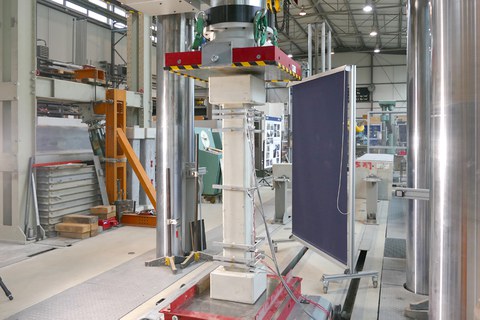Carbonbeton in Syrien
Inhaltsverzeichnis
Projektdaten
|
Titel | Title |
Bericht aus dem Jahrbuch 2021
Carbonbeton in Syrien

Übliche Verstärkungsmethoden in Syrien
Im Forschungsprojekt wurde das Potential für den Einsatz von Carbonbeton in Syrien analysiert und Handlungsempfehlungen sowie Berechnungsalgorithmen, angepasst an regionale Besonderheiten, erarbeitet.
Die Bauwerke in Syrien unterliegen, verglichen z. B. mit denen in Deutschland, zum Teil abweichenden, besonderen Beanspruchungen, die sowohl spezielle Konstruktionsweisen als auch einen besonderen Umgang mit dem Bestand erfordern. Konkret handelt es sich einerseits um die natürliche Einwirkung Erdbeben. Andererseits ist ein Großteil der vorhandenen Bauwerke von extremen Lasten infolge des Krieges beansprucht.
In Deutschland wird vor allem seit Mitte der 1990er Jahre ein neuer Baustoff intensiv erforscht. Textil- oder Carbonbeton (TRC bzw. CRC) weist viele Eigenschaften auf, die ihm gegenüber der herkömmlichen Massivbauweise Vorteile verschaffen. Bereits dünne, materialeffiziente Schichten sind geeignet, um die Tragfähigkeit deutlich anzuheben oder die Gebrauchstauglichkeit zu verbessern. Dies gilt sowohl für den statischen Belastungsfall, aber auch für wiederholte Anregungen. Dies alles macht Textil- oder Carbonbeton prädestiniert für den Einsatz in meinem Heimatland.
Am Institut für Massivbau der TU Dresden bestand die Möglichkeit, eng mit hervorragenden Fachleuten auf diesem Gebiet zusammenzuarbeiten, ein umfassendes Wissen zu erwerben und gleichzeitig ein Konzept für die Anwendung von Textilbeton bei kriegs- und erdbebengeschädigten Bauwerken in Syrien zu erarbeiten. 2021 lag der Fokus auf folgenden Arbeitspunkten:
- Zusammenfassung der häufigsten Schadensbilder und Defizite im Bestand,
- Darstellung der in Syrien üblicherweise angewendeten Verstärkungsmaßnahmen an ausgewählten Beispielen,
- Durchführung von Laborversuchen mit Carbonbeton zur Kennwertermittlung,
- Vergleiche zwischen herkömmlichen Methoden der Verstärkung in Syrien und der
- Verstärkung mit Anwendung von Carbonbeton,
- Finalisierung eines Instandsetzungs- und Ertüchtigungskonzeptes für ausgewählte Bauwerks- und Schadenstypen,
- Unterlegung des Konzeptes mittels Berechnungen und Simulationen, gestützt auf die Versuchsergebnisse aus dem Labor.
Abschließend wurden die Berechnungsalgorithmen mit ausgewählten Beispielen ergänzt.
Bericht aus dem Jahrbuch 2020
Einsatz von Carbonbeton in Syrien

Versuche mit verstärkten Stützen
Carbonbeton ist eine vielversprechende Methode, um beschädigte oder nicht ausreichend tragfähige Bauwerke zu verstärken und somit zu erhalten. Im Projekt werden das Potential für den Einsatz von Carbonbeton in Syrien analysiert und Handlungsempfehlungen sowie Berechnungsalgorithmen, angepasst an regionale Besonderheiten, erarbeitet.
Die Bauwerke in Syrien unterliegen, verglichen z. B. mit denen in Deutschland, zum Teil abweichenden, besonderen Beanspruchungen, die sowohl spezielle Konstruktionsweisen als auch einen besonderen Umgang mit dem Bestand erfordern. Konkret handelt es sich einerseits um die natürliche Einwirkung Erdbeben. Andererseits ist ein Großteil der vorhandenen Bauwerke von extremen Lasten infolge des Krieges beansprucht.
Maßgeblich in Deutschland wird seit etwa 20 Jahren ein neuer Baustoff erforscht. Textil- oder Carbonbeton weist viele Eigenschaften auf, die ihm gegenüber der herkömmlichen Massivbauweise Vorteile verschaffen. Bereits dünne, materialeffiziente Schichten sind geeignet, um die Tragfähigkeit deutlich anzuheben oder die Gebrauchstauglichkeit zu verbessern. Dies gilt sowohl für den statischen Belastungsfall, aber auch für wiederholte Anregungen. Dies alles macht Textil- oder Carbonbeton prädestiniert für den Einsatz in meinem Heimatland.
An der TU Dresden bietet sich mir die Möglichkeit, eng mit hervorragenden Fachleuten auf diesem Gebiet zusammenzuarbeiten, ein umfassendes Wissen zu erwerben, Kontakte zu Herstellern und ausführenden Baufirmen zu knüpfen und gleichzeitig ein Konzept für die Anwendung von Textilbeton bei kriegs- und erdbebengeschädigten Bauwerken in Syrien zu erarbeiten.
Der Fokus der Forschung lag bisher auf:
- Analyse des Bauwerksbestands in Syrien und Zusammenstellung der wahrscheinlich häufigsten Schadensbilder bzw. Defizite im Bestand,
- Erarbeitung von Instandsetzungs- und Ertüchtigungskonzepten für ausgewählte Bauwerks- und Schadenstypen, basiert auf den gewonnen Versuchsergebnissen der laufenden Versuche am OML der TU Dresden.
Zukünftig sollen verschiedene Parameter hinsichtlich Unterlegung dieser Konzepte durch Berechnungen/Simulationen und ggf. Versuche im Labor weiter bearbeitet werden.
